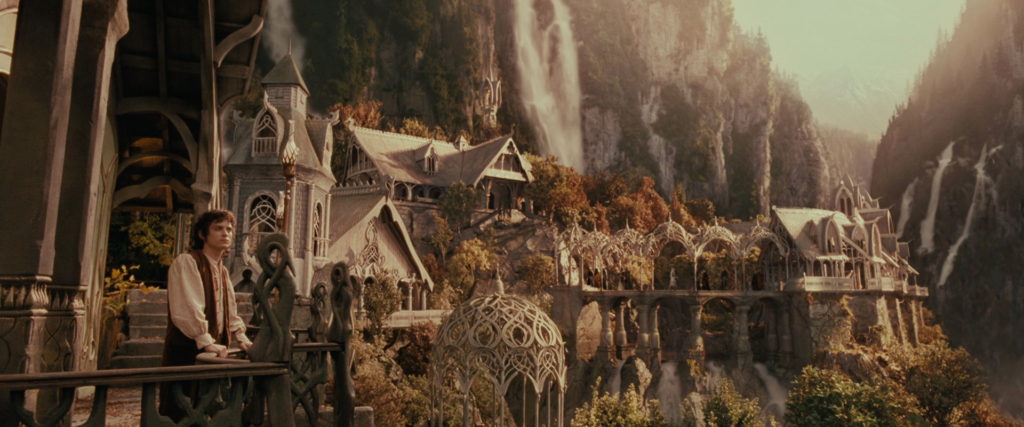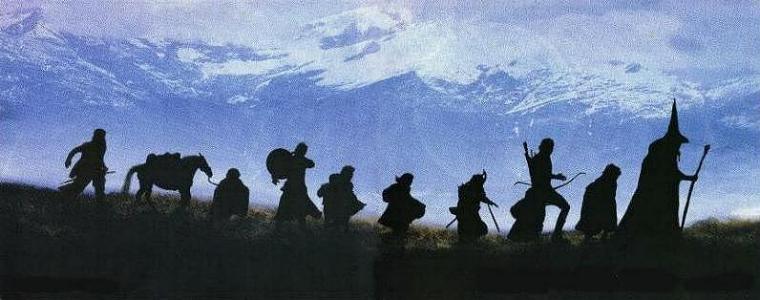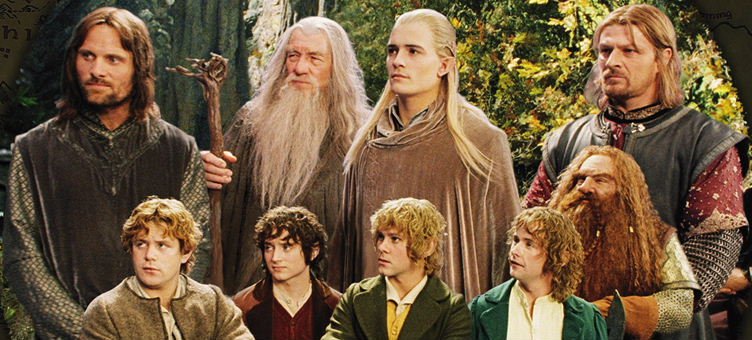The Lord of the Rings: The Fellowship of the Ring (2001)
CAST: Elijah Wood, Ian McKellen, Viggo Mortensen, Sean Astin, Sean Bean, Liv Tyler, Cate Blanchett, John Rhys-Davies, Billy Boyd, Dominic Monaghan, Orlando Bloom, Christopher Lee, Ian Holm, Hugo Weaving, Andy Serkis
REVIEW:
The origins of this epic film trilogy date back to the early 1930s, when a British scholar named J.R.R. Tolkien began writing an equally epic series of books. The first to be completed and published was The Hobbit in 1937, but Tolkien had a more ambitious story in mind. Originally setting out to write one enormous novel, he ultimately realized that such a tale as he was spinning was too vast to be contained in one book, and instead formed it into a trilogy. Parts one and two, The Fellowship of the Ring and The Two Towers, were released in 1954, followed by the climax, The Return of the King, in 1957. Together, the trilogy was known as The Lord of the Rings. The significance of this fantasy series cannot be understated. Tolkien’s books were adored by millions the world over during his time, and since his death in 1973, they have remained a beloved and integral part of the fantasy literature genre. With such a following, it was inevitable that film versions would at least be attempted, but few filmmakers had either the inclination or the means to tackle such a daunting production. Mediocre animated versions of both The Lord of the Rings and its prequel The Hobbit were made—and flopped—in the 1970s, with the poor quality of the animation and various story omissions rankling fans. Two more decades passed, and finally New Zealand director Peter Jackson has taken on the ambitious task of bringing Tolkien’s epic trilogy to the big screen with the backing of New Line Cinema’s investment of nearly $300 million for the package deal of all three installments. Those worried about whether it is even possible to translate The Lord of the Rings intact to the screen can breathe a sigh of relief, at least if this first installment is any indication. Jackson and his cast and crew have succeeded on every level, and the result is not only a definitive film adaptation of part one of one of the most popular fantasy stories ever written, not only a majestic, enthralling adventure in its own right, but itself a pinnacle in filmmaking, one of the most colossal film productions ever made, and raising the meaning of “epic filmmaking” to a whole new level. In the future all epic fantasy adventures—including its own sequels—will have a high bar to hurdle.
The set-up is explained in a concise and straightforward opening prologue narrated by Cate Blanchett. Thousands of years ago, a great war was waged between the free peoples of Middle Earth—including humans, elves, and dwarves—and the forces of evil led by the Dark Lord Sauron, whose power stemmed from a magical ring. Sauron was defeated, but his life force endured through the ring, corrupting the various hands it has passed through ever since. When we begin with our story, the ring now belongs to the Hobbit Bilbo Baggins (Ian Holm), the adventurous hero of The Hobbit, who has retired in his old age to the peaceful countryside of The Shire, the living place of the Hobbits, diminutive, sheltered country folk who live blissfully isolated from the greater world. But life does not proceed uneventfully; Bilbo is visited on his 111th birthday by his old friend, the wizard Gandalf (Ian McKellen), who has come with news that danger is growing in the outside world. Bilbo has had the ring too long, weary of the effects of its malevolent power, and Sauron’s agents, the ring-wraiths, are finally closing in. The only way to keep the ring out of Sauron’s grasp is to take it to Sauron’s own land of Mordor and cast it into the fire of Mount Doom where it was forged, thereby destroying both the ring and Sauron himself. This unenviable task falls on the small shoulders of Bilbo’s young nephew and heir Frodo (Elijah Wood), to whom he turns over the ring. After several close calls with the ring-wraiths, Frodo and his faithful fellow Hobbit traveling companions Sam (Sean Astin), Merry (Dominic Monaghan), and Pippin (Billy Boyd) make their way to the Elf land of Rivendell, where a Fellowship of the Ring is formed to help Frodo on his perilous mission, including his Hobbit companions, Gandalf, the elf archer Legolas (Orlando Bloom), surly dwarf Gimli (John Rhys-Davies), ambitious human heir Boromir (Sean Bean), and the mysterious Aragorn (Viggo Mortensen). These nine companions, occasionally with assistance from Aragorn’s elf love Arwen (Liv Tyler) and the elven Queen Galadriel (Cate Blanchett) must make the long and dangerous journey to Mordor, confronting ever mounting perils, with the seducing and corrupting influence of the ring threatening to divide them. And this is only part one of three.
 Peter Jackson, while cutting or condensing a number of scenes to quicken the pace and adding a minor romantic subplot, was determined to remain faithful to the spirit and essence of Tolkien’s works. Jackson and an obviously dedicated crew have brought Tolkien’s fantasy world to life with a richness and detail that makes Middle Earth seem like not like some elaborate movie set, but a real place that we could visit, where people actually live. As an example of their attention to detail and commitment to making this fantasy world as “lived-in” as possible, they planted crops a year beforehand on the location of Hobbiton, whose charming, quaintly idyllic look and feel perfectly captures the peaceful natures and innocence of the Hobbits. A sense of discovery lies behind every frame, taking us to an endless series of new places so rich and beautifully rendered that we can almost believe they truly exist. The remarkably diverse New Zealand terrain was a great help in this. While Jackson and his special effects team did use some CGI—which sometimes isn’t quite as polished as that in some other films—they used it sparingly, preferring to rely primarily on actual meticulously constructed sets whenever possible, resulting in a world that looks and feels more real than the excessive CGI and green screen of the Star Wars prequels. Camera trickery is also utilized to give the actors playing the Hobbits—and John Rhys-Davies as the dwarf Gimli—a miniaturized appearance. Howard Shore’s score hits all the right notes at all the right moments, from the Celtic-flavored Shire score to the more epic main theme. Andrew Lesnie’s suitably epic, sweeping cinematography displays the New Zealand countryside for all it’s worth. And the movie is more than just visually stunning. It never ceases to engage throughout its entire formidable runtime, and many sequences are genuinely exciting—a chase with the ring-wraiths, a hazardous trek through the underground caverns of Moria, a climactic battle—and it transitions from light-hearted to darker, more serious moments without ever making a misstep. In every way imaginable, this is a production virtually devoid of any significant flaws, and it is difficult to imagine a film adaptation possibly being better-done.
Peter Jackson, while cutting or condensing a number of scenes to quicken the pace and adding a minor romantic subplot, was determined to remain faithful to the spirit and essence of Tolkien’s works. Jackson and an obviously dedicated crew have brought Tolkien’s fantasy world to life with a richness and detail that makes Middle Earth seem like not like some elaborate movie set, but a real place that we could visit, where people actually live. As an example of their attention to detail and commitment to making this fantasy world as “lived-in” as possible, they planted crops a year beforehand on the location of Hobbiton, whose charming, quaintly idyllic look and feel perfectly captures the peaceful natures and innocence of the Hobbits. A sense of discovery lies behind every frame, taking us to an endless series of new places so rich and beautifully rendered that we can almost believe they truly exist. The remarkably diverse New Zealand terrain was a great help in this. While Jackson and his special effects team did use some CGI—which sometimes isn’t quite as polished as that in some other films—they used it sparingly, preferring to rely primarily on actual meticulously constructed sets whenever possible, resulting in a world that looks and feels more real than the excessive CGI and green screen of the Star Wars prequels. Camera trickery is also utilized to give the actors playing the Hobbits—and John Rhys-Davies as the dwarf Gimli—a miniaturized appearance. Howard Shore’s score hits all the right notes at all the right moments, from the Celtic-flavored Shire score to the more epic main theme. Andrew Lesnie’s suitably epic, sweeping cinematography displays the New Zealand countryside for all it’s worth. And the movie is more than just visually stunning. It never ceases to engage throughout its entire formidable runtime, and many sequences are genuinely exciting—a chase with the ring-wraiths, a hazardous trek through the underground caverns of Moria, a climactic battle—and it transitions from light-hearted to darker, more serious moments without ever making a misstep. In every way imaginable, this is a production virtually devoid of any significant flaws, and it is difficult to imagine a film adaptation possibly being better-done.
 This might not be considered an “actors’ movie”, but the entire ensemble cast unanimously slip comfortably into their roles and acquit themselves well with what they’re given. While filling out the numerous roles onhand, finding the best fits for the parts took priority over stocking them with “big names”, and the effort has paid off; there’s not a miscasting to be found. Elijah Wood brings a sense of earnest innocence to Frodo Baggins as the sheltered young Hobbit is suddenly thrust into the position of being the person upon whom the fate of the world might hinge. Viggo Mortensen is right at home in the role of the rugged sword-wielding fantasy hero. Ian McKellen is wonderful as Gandalf, the benevolent and wise mentor who sets the Fellowship off on their critical mission, and Ian Holm’s Bilbo is a troubled and poignant figure; the latter doesn’t have a lot of screentime, but he makes an impression. Sean Bean, often typecast as one-dimensional villains, gets a meatier role that shows more of his underrated range as the conflicted and increasingly tormented Boromir, torn between noble intentions and the seductive allure of the ring, while Sean Astin is the pure-hearted Samwise Gamgee, whose loyalty to Frodo seems limitless. The rest of the cast doesn’t have as substantive material. Dominic Monaghan, John Rhys-Davies, and the endearingly impish Billy Boyd are on-hand primarily for comic relief, and Orlando Bloom doesn’t have too much to do besides look pretty and shoot arrows at lightning speed. Well-respected thespians like Cate Blanchett and Hugo Weaving bring their authoritative presences to smaller walk-on roles as Galadriel and the Elf lord Elrond, and Liv Tyler brings a nice ethereal quality to Arwen. With the Dark Lord Sauron represented by a huge flaming eye, the most visible villain is supplied by Christopher Lee, who brings his commanding, sinister presence to Gandalf’s treacherous fellow wizard Saruman.
This might not be considered an “actors’ movie”, but the entire ensemble cast unanimously slip comfortably into their roles and acquit themselves well with what they’re given. While filling out the numerous roles onhand, finding the best fits for the parts took priority over stocking them with “big names”, and the effort has paid off; there’s not a miscasting to be found. Elijah Wood brings a sense of earnest innocence to Frodo Baggins as the sheltered young Hobbit is suddenly thrust into the position of being the person upon whom the fate of the world might hinge. Viggo Mortensen is right at home in the role of the rugged sword-wielding fantasy hero. Ian McKellen is wonderful as Gandalf, the benevolent and wise mentor who sets the Fellowship off on their critical mission, and Ian Holm’s Bilbo is a troubled and poignant figure; the latter doesn’t have a lot of screentime, but he makes an impression. Sean Bean, often typecast as one-dimensional villains, gets a meatier role that shows more of his underrated range as the conflicted and increasingly tormented Boromir, torn between noble intentions and the seductive allure of the ring, while Sean Astin is the pure-hearted Samwise Gamgee, whose loyalty to Frodo seems limitless. The rest of the cast doesn’t have as substantive material. Dominic Monaghan, John Rhys-Davies, and the endearingly impish Billy Boyd are on-hand primarily for comic relief, and Orlando Bloom doesn’t have too much to do besides look pretty and shoot arrows at lightning speed. Well-respected thespians like Cate Blanchett and Hugo Weaving bring their authoritative presences to smaller walk-on roles as Galadriel and the Elf lord Elrond, and Liv Tyler brings a nice ethereal quality to Arwen. With the Dark Lord Sauron represented by a huge flaming eye, the most visible villain is supplied by Christopher Lee, who brings his commanding, sinister presence to Gandalf’s treacherous fellow wizard Saruman.
As it stands on its own, The Fellowship of the Ring is an enthralling fantasy adventure which pulls you into its world and keeps you happily there for a running time which exceeds three hours, with humor, action, and dashes of romance and tragedy. The open “to be continued” ending is inevitable, but this first chapter caps off at a satisfactory stopping point. Regardless of what the future holds, it stands on its own merits as one of the most rousing fantasy adventures ever to reach a theater screen. Thus far, The Lord of the Rings is in good hands.
* * * *
